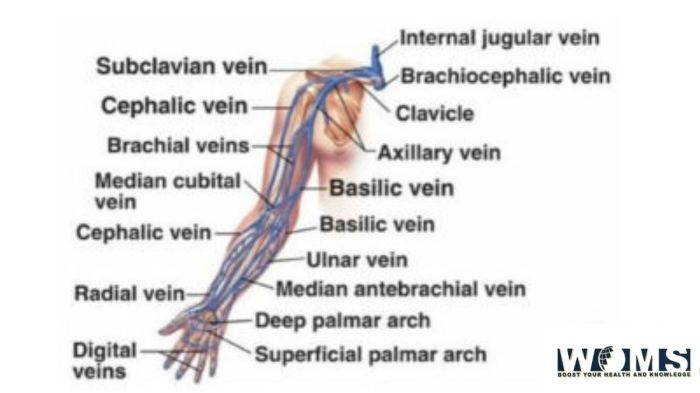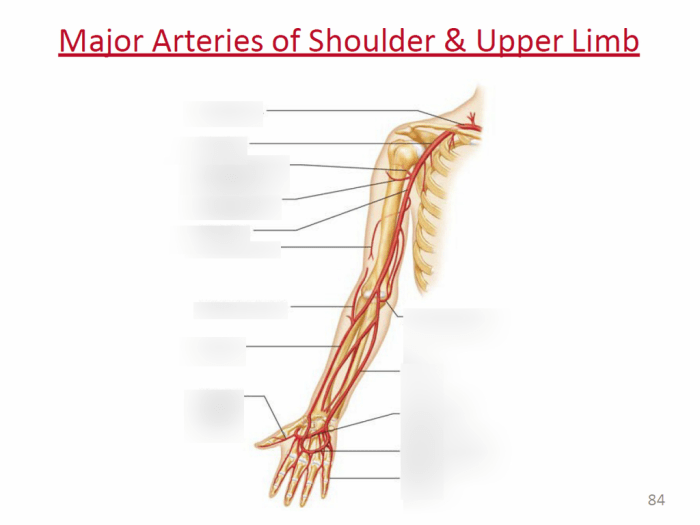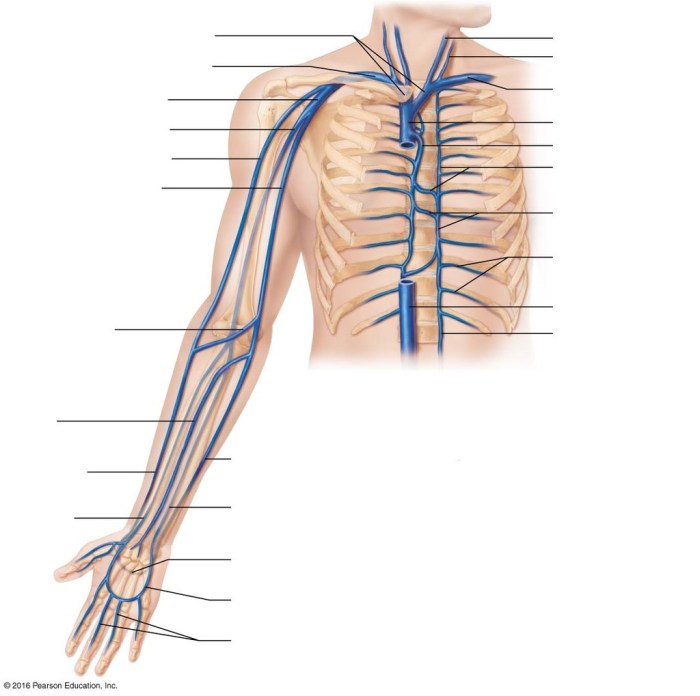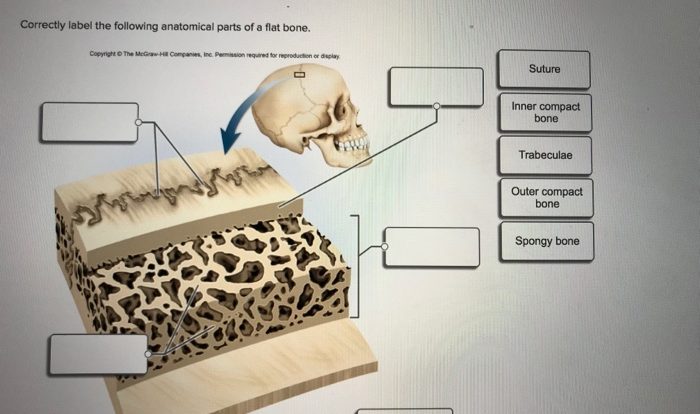Label the veins of the upper limb and shoulder – Labeling the veins of the upper limb and shoulder is a crucial aspect of understanding the anatomy of this region. This comprehensive guide delves into the superficial and deep veins of the upper limb, explores the veins of the anterior and posterior shoulder, and highlights their clinical significance.
The upper limb and shoulder veins play a vital role in blood circulation and serve as access points for various medical procedures. This guide provides a detailed overview of these veins, their locations, and their implications in clinical practice.
1. Veins of the Upper Limb

The veins of the upper limb can be divided into two groups: superficial veins and deep veins.
Superficial Veins of the Upper Limb
The superficial veins of the upper limb are located just beneath the skin. They are relatively easy to see and feel, and they are often used for blood draws and intravenous injections.
- Cephalic vein:This vein runs along the lateral side of the forearm and into the antecubital fossa. It is the most commonly used vein for blood draws.
- Basilic vein:This vein runs along the medial side of the forearm and into the antecubital fossa. It is less commonly used for blood draws than the cephalic vein.
- Median cubital vein:This vein runs across the antecubital fossa and connects the cephalic and basilic veins. It is often used for intravenous injections.
- Radial veins:These veins run along the lateral side of the hand and forearm. They are often used for blood draws in infants and children.
- Ulnar veins:These veins run along the medial side of the hand and forearm. They are less commonly used for blood draws than the radial veins.
Deep Veins of the Upper Limb
The deep veins of the upper limb are located deep within the muscles. They are not as easy to see or feel as the superficial veins, and they are not as commonly used for blood draws or intravenous injections.
- Brachial veins:These veins run along the medial side of the arm. They drain blood from the forearm and hand.
- Axillary vein:This vein runs along the lateral side of the arm and into the axilla. It drains blood from the brachial veins and the superficial veins of the upper limb.
- Subclavian vein:This vein runs along the medial side of the clavicle and into the chest. It drains blood from the axillary vein.
Comparison of Superficial and Deep Veins of the Upper Limb
| Feature | Superficial Veins | Deep Veins |
|---|---|---|
| Location | Just beneath the skin | Deep within the muscles |
| Visibility and palpability | Easy to see and feel | Not as easy to see or feel |
| Use for blood draws and intravenous injections | Commonly used | Not as commonly used |
2. Veins of the Shoulder

The veins of the shoulder can be divided into two groups: veins of the anterior shoulder and veins of the posterior shoulder.
Veins of the Anterior Shoulder
The veins of the anterior shoulder drain blood from the anterior part of the shoulder.
- Cephalic vein:This vein runs along the lateral side of the shoulder and into the antecubital fossa.
- Deltopectoral vein:This vein runs along the deltopectoral groove and into the axillary vein.
- Thoracoacromial vein:This vein runs along the thoracoacromial artery and into the axillary vein.
Veins of the Posterior Shoulder
The veins of the posterior shoulder drain blood from the posterior part of the shoulder.
- Axillary vein:This vein runs along the lateral side of the shoulder and into the axilla.
- Subscapular vein:This vein runs along the subscapularis muscle and into the axillary vein.
- Circumflex scapular vein:This vein runs around the lateral border of the scapula and into the axillary vein.
Diagram of the Veins of the Shoulder
[Diagram of the veins of the shoulder]
3. Clinical Significance: Label The Veins Of The Upper Limb And Shoulder
The veins of the upper limb and shoulder are clinically significant for several reasons.
Clinical Significance of the Veins of the Upper Limb, Label the veins of the upper limb and shoulder
- Blood draws:The superficial veins of the upper limb are commonly used for blood draws.
- Intravenous injections:The superficial veins of the upper limb are also commonly used for intravenous injections.
- Venous access for hemodialysis:The deep veins of the upper limb can be used for venous access for hemodialysis.
- Venous thrombosis:The deep veins of the upper limb can be at risk for venous thrombosis, which is a blood clot in a vein.
Clinical Significance of the Veins of the Shoulder
- Venous access for surgery:The axillary vein is often used for venous access during surgery on the shoulder or chest.
- Venous thrombosis:The axillary vein can be at risk for venous thrombosis, which is a blood clot in a vein.
Potential Complications Associated with the Veins of the Upper Limb and Shoulder
- Phlebitis:This is an inflammation of a vein.
- Venous thrombosis:This is a blood clot in a vein.
- Lymphedema:This is a swelling of the arm or shoulder due to a blockage in the lymphatic system.
4. Additional Resources

Links to Relevant Articles and Websites
Glossary of Terms
- Antecubital fossa:The area of the elbow where the brachial artery and veins are located.
- Axilla:The armpit.
- Clavicle:The collarbone.
- Deltopectoral groove:The groove between the deltoid and pectoralis major muscles.
- Lymphatic system:A network of vessels and nodes that helps to drain fluid from the tissues.
- Scapula:The shoulder blade.
- Subscapularis muscle:A muscle located on the anterior surface of the scapula.
- Thoracoacromial artery:An artery that supplies blood to the shoulder.
Quiz
- What are the three main superficial veins of the upper limb?
- What is the name of the vein that runs along the lateral side of the shoulder?
- What is the most common complication associated with the veins of the upper limb and shoulder?
FAQ
What are the main superficial veins of the upper limb?
The main superficial veins of the upper limb include the cephalic vein, basilic vein, and median cubital vein.
What is the clinical significance of the veins of the upper limb and shoulder?
The veins of the upper limb and shoulder are important for blood circulation and serve as access points for various medical procedures, such as intravenous injections and blood draws.
What are some potential complications associated with the veins of the upper limb and shoulder?
Potential complications associated with the veins of the upper limb and shoulder include thrombosis, phlebitis, and lymphedema.
